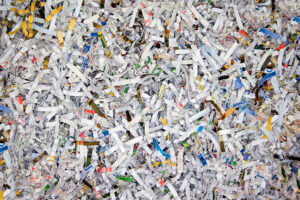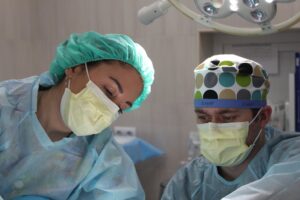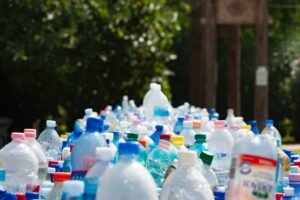In our previous post we looked at how traditional medical waste disposal harms our environment. Although there are greener and cheaper ways to dispose of medical waste, small generators (clinics, medical & dental practices, etc) typically hire a third-party hauler to take away their medical waste. That hauler then takes the waste to a transfer facility where it is collated, then to a treatment facility for sterilization, and finally to a landfill.
How does medical waste affect the environment?
The significant environmental harm comes from the large carbon footprint this traditional process leaves behind. The trucks often make long haul distances to get medical waste to treatment facilities, and then travel to the final landfill destination.

Processing medical waste at the site of generation, which is low-cost technology that exists today, leaves a much smaller carbon footprint.
We also learned in our first article that a solid measure in ensuring a business makes a true dent in their environmental impact. This is a firm action that does not rely on staff or customers to take any specific steps, like segmenting waste, to make sure a difference is made.
We have a sustainable solution for small to medium medical waste generators that allows for the easy sterilization of medical waste on-premise, allowing you to discard the treated remains in your regular municipal trash.
Just how much emissions can be cut down using an onsite solution? Please refer to our graph below.
The graph shows the CO2 saved for the top 7 and bottom 7 states in the US. Vermont has super clean electrical power, so the electricity the TE-5000 uses costs very little in CO2. Wyoming has less clean methods of producing electricity, so the savings is less, but still a savings. The cost of haul-away is the same for every state.
Who are we?
OnSite Waste Technologies is a Newport Beach California-based company dedicated to reducing the cost, risk, and environmental impact of medical waste processing and disposal.
Our TE-5000 is an innovative desktop-sized processing unit that converts regulated medical waste like syringes into sterile garbage that can be placed in a practice’s regular trash.
This solution is a greener, cheaper, and safer option for handling medical waste disposal than typical haul-away services.
According to the U.S. Energy Information Administration, “About 80 percent of greenhouse gas emissions that cause climate change stem from burning fossil fuels”. Cutting down the amount of time disposal trucks are on roads will make a huge impact. With our solution you can achieve this without added cost or inconvenience.
Additionally, incinerating medical wastes has been the go-to disposal process of the industry, however incineration itself is not without harm. According to Transparency Market Research, more non-incineration options are being offered as people look for ways to limit the emissions of carbon monoxide, sulfur dioxide, and dioxins that can be released through incineration. Although the Environmental Protection Agency has strict air emission limits on incineration, some of these still get through into our air during the process.
With the TE-5000, all medical waste is disposed of onsite in an environmentally friendly process.
The TE-5000 system meets CDC and EPA recommendations for treatment and is consistent with the requirements under the OSHA Bloodborne Pathogen Rule. The TE-5000 meets requirements for treatment in 49 states.

Some other added benefits of treating medical waste onsite include:
- The TE-5000 uses a thermal process to sterilize medical waste, which reduces the mass of the material that ends up in landfills as well as limits any off gassing of hazardous material that incineration poses.
- Liability issues are limited. When you use a third-party hauler, if they break travel and manifestations requirements or are not OSHA compliant, you can face repercussions due to your cradle-to-grave liability – liability does not go away after pickup!
- Less problems with storing medical waste onsite awaiting pick up. Some practices are impacted by sharps container thefts and issues with scheduling pick ups due to being located in remote areas.











